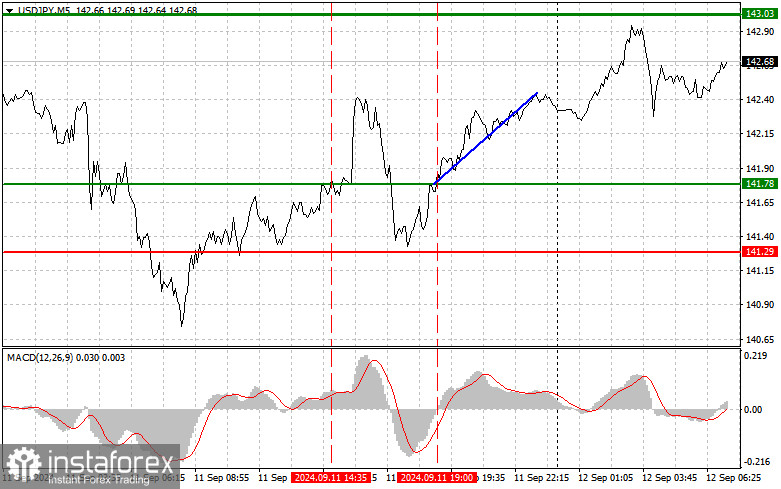Trade Analysis and Advice for Trading the Japanese Yen
The price test at 141.78 coincided with the moment when the MACD indicator started moving upward from the zero mark, confirming the correct entry point for buying the dollar in anticipation of a correction. As a result, the pair rose by 60 pips. Data on U.S. inflation restored demand for the dollar in the second half of the day, leading to a decent recovery of the pair after its sharp decline, which occurred following a statement by Bank of Japan board member Junko Nakagawa, who mentioned the need for further interest rate hikes in Japan. Today, the dollar may rise even more, but viewing this as a good opportunity to sell rather than betting on a more significant upward correction of the pair is better. As for the intraday strategy, I will rely more on the realization of scenarios No. 1 and 2.

Buy Signal
Scenario No. 1: Today, I plan to buy USD/JPY at the entry point around 142.87 (green line on the chart), aiming for a rise to the level of 143.73 (thicker green line on the chart). Around 143.73, I plan to exit the long positions and open shorts in the opposite direction, aiming for a movement of 30-35 pips in the opposite direction from the entry level. The pair's growth today can only be expected within the correction framework. Important! Before buying, ensure the MACD indicator is above the zero mark and starting its upward movement.
Scenario No. 2: I also plan to buy USD/JPY today if the price tests 142.37 twice and the MACD indicator is in the oversold area. This will limit the pair's downward potential and lead to an upward market reversal. A rise to the opposite levels of 142.87 and 143.73 can be expected.
Sell Signal
Scenario No. 1: I plan to sell USD/JPY today only after testing the level of 142.37 (red line on the chart), leading to a rapid decline in the pair. The key target for sellers will be the 141.50 level, where I plan to exit short positions and immediately open longs in the opposite direction (expecting a movement of 20-25 pips in the opposite direction from the level). Pressure on the pair could return as the bearish market for the dollar remains in place. Important! Before selling, make sure the MACD indicator is below the zero mark and just starting its downward movement.
Scenario No. 2: I also plan to sell USD/JPY today if the price tests 142.87 twice and the MACD indicator is in the overbought area. This will limit the pair's upside potential and lead to a market reversal downward. A decline to the opposite levels of 142.37 and 141.50 can be expected.

What's on the Chart:
Thin green line: the entry price at which you can buy the trading instrument.
Thick green line: the estimated price at which you can set Take Profit or manually close positions, as further growth above this level is unlikely.
Thin red line: the entry price at which you can sell the trading instrument.
Thick red line: an estimated price at which you can place Take Profit or manually close positions, as further decline below this level is unlikely.
MACD indicator: when entering the market, it is essential to be guided by overbought and oversold zones.
Important: Novice traders in the forex market need to be very careful when making decisions about entering the market. It is best to stay out of the market before important fundamental reports are released to avoid getting caught in sharp price fluctuations. If you decide to trade during news releases, always place stop orders to minimize losses. You must set stop orders to avoid losing your entire deposit, especially if you don't use money management and trade in large volumes.
Remember, a clear trading plan, like the one I've outlined, is essential for successful trading. Making impulsive decisions based on the current market situation is a losing strategy for novice intraday traders.
 English
English 
 Русский
Русский Bahasa Indonesia
Bahasa Indonesia Bahasa Malay
Bahasa Malay ไทย
ไทย Español
Español Deutsch
Deutsch Български
Български Français
Français Tiếng Việt
Tiếng Việt 中文
中文 বাংলা
বাংলা हिन्दी
हिन्दी Čeština
Čeština Українська
Українська Română
Română

